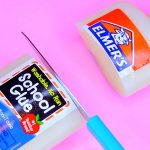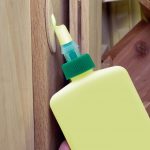If adhesive has built up on your wall, it’s tempting to just peel off the sticker.
However, destroying paint to get to it could result in damage. Removing adhesive from a wall without damaging the paint can be done using various methods.
So, how do you remove adhesive from a wall without damaging paint?
Let’s start now.
How To Remove Adhesive From Wall Without Damaging Paint
Contents
Sand Down the Residue
If you’ve tried all of the previous methods and there’s still some glue left on the wall or trim, it might be time to bring out the sandpaper.
When sanding, try to get rid of as much of the glue as possible instead of taking off all of the paint.
You can repaint the areas after the glue has been taken off and the area has been sanded. This will keep the walls from being damaged for good.
Your walls will be smooth after removing all traces of the glue.
However, remember that sanding may cause some damage to the paint, and you may need to replace a coat of paint on the areas that were sanded down.
In other words, before doing this last step, ensure that the walls are clean and free of dust and other debris that could stick to the newly exposed walls while painting them.
Keep in mind that sanding might cause some damage to your walls and might require repainting afterward.
To begin this procedure, use a piece of sandpaper to sand over the area affected by glue until it is shiny and smooth. Pay special attention to the edges, where glue tends to stick the most. It is okay if some paint still remains around these edges; just sand it enough to create a clean surface.
Applying these methods will help you know how to remove adhesive from a wall without damaging the paint. There are different ways to remove adhesive from a wall depending on the amount, strength, and type of the residue left behind.
Go over the protruding areas gently with the sandpaper until they become smooth and even with the rest of the wall.
Repaint the area once the glue has been removed and the area has been sanded down to prevent permanent damage to the walls.
Heat Up the Glue
Heat is the last and most effective way to remove stubborn pieces of glue without leaving any marks or scratches on the wall.
This is also an effective method for those who have used wallpaper paste as the glue on the wallpaper because the heat softens the paper and makes it easy to peel off in one piece.
For this, you may use a hair dryer or a blowtorch to heat the glue and soften it up.
Heat can loosen the bond between the wall and the residue of the glue, making it easier to remove it without causing any damage to the walls.
So, using a sharp and pointed object such as an ice pick or a butter knife, scrape off all the dried paste that is still stuck on the walls.
Scrape off the residue while applying gentle pressure along the area where the adhesive was stuck onto the wall.
Heat is great at loosening the bond between the residue of the glue and the wall, making it much easier to peel off without leaving any traces behind.
At the same time, heat can also damage the paint on the walls, so avoid using this method when your walls still have their original color.
Be very careful when using a sharp object to scrape off leftover wallpaper paste, because it could damage the paint on the walls and make things worse.
Rub With Oil
Oil may be used as an alternative to heat for removing stubborn traces of sticky adhesives left on your walls.
Oiling the glue will loosen the bond between the paint and the walls, making it easier to remove the remains without damaging the paint job.
To apply oil, use a clean cloth to rub the oil over the area affected by the residual adhesive until the surface is shiny and smooth.
Keep in mind, though, that the oil is not a permanent solution; you will have to reapply it every 2 to 3 months to prevent the stickiness from returning.
As a result, it is best that you only apply this method to walls that already have a new coat of paint.
For this stage, you may use petroleum jelly, olive oil, or vegetable oil as these substances are safe to use on walls without damaging the paint job.
After removing the glue, thoroughly wash and dry the area to remove any traces of oil left behind to avoid attracting more dust and dirt on the wall surface.
This will help bring back the paint’s shine and keep it from coming off in the future.
Use Soap and Warm Water
One of the most efficient techniques for removing old wallpaper is using a soap solution with hot water to soften the glue and make it much easier to remove from the wall surface.
As the solution dissolves the residue, it may also loosen up the bond between the paint and the walls, making it easier to remove them without causing any damage to the walls.
The first step is mixing warm water with a detergent such as dish soap and then wiping the solution over the area affected by the old wallpaper paste until all the residues are gone.
Dish soap is safe to use on most surfaces, but avoid using it on glossy surfaces because it can damage them.
Then, dampen the adhesive residue with a mixture of warm water and dish detergent until the surface is soft and it becomes easy to remove from the wall.
You may also use an oil-based lubricant if the stain is particularly stubborn.
When the glue has been wet, use a sponge or a soft brush to scrub it off the surface carefully to prevent damaging the walls.
Remove It Using a Scraper
After applying friction, use a spatula or a plastic scraper to scrape off the old adhesive from the wall until there are no more signs of it.
And it’s critical to do all of this before repainting your walls.
Begin at one edge and work your way across, using the spatula to scrape away as much of the remaining glue as possible without harming your paint.
This will lift the residue, making it easier to wipe away the rest of the wall and preventing the damaged paint from peeling off later.
Keep your blade virtually parallel with the wall as you scrape, so you don’t gouge the surface and leave unsightly scratches behind.
If you’re dealing with less persistent stains, you can pour some vinegar onto the glue and then wipe it away with a sponge.
However, there will very certainly still be some remnants left on the wall.
Remove them by rubbing some ice cubes over the stained area and scraping them off using a plastic scraper.
Make Use of Friction
When removing any glue, be it wallpaper or superglue, the first step is always to apply friction to soften it and make it much easier to remove from the surface without damaging the paint.
This initial process will not remove the stain completely, but it will make it easier to clean it off later without damaging the walls.
It will, however, aid in the removal of the other residual remains, like the gluey substance that falls off after you remove the tape and the stickers on the walls.
Begin by peeling from one corner and pulling upwards to remove the paper.
Then, using light pressure, apply some force to the edges and try to loosen the paper at the corners by applying some friction to the edges and pulling the wallpaper up slowly.
Work slowly and firmly to avoid tearing the paper and making holes in the surface that won’t look good. Keep going until you’ve taken off the whole strip of wallpaper.
Although this procedure is time-consuming, it is the best way to remove wallpaper without leaving any marks behind.
Inspect the Glue Thoroughly
Before starting the removal process, you must first look at the damage carefully and make a good estimate of how bad it is.
Depending on the kind, you may either have to scrape off the residue with a plastic scraper or use vinegar to remove it with a bit of scrubbing.
If it’s tape residue, for example, gently tugging the tape with your fingernails should remove most of it easily enough.
Heating the area with a blow dryer or heating pad also works well to loosen stubborn residues and make them easier to remove.
How To Remove Adhesive Hooks From Wall Without Damaging Paint
Heat the glue with an iron before removing it with a razor blade and a putty knife.
This will help to loosen the glue and make the removal process much easier.
Once the glue has softened enough to make it easy to pull off, gently pull the hook away from the wall.
If none of the aforementioned ways work, you may have to repaint the walls or hire a contractor to do the job for you.
Rub it onto the surface of the adhesive and let it dry for 10 minutes or so before wiping it off with a clean cloth.
Wait a few minutes and then repeat the process until the glue has all been removed from the wall without damaging it too much.
How To Remove Adhesive From Painted Walls
Most adhesives on painted walls may easily be cleaned off using a damp cloth and warm soapy water.
If the glue is really persistent, you may also use white vinegar and a plastic scraper to remove it without damaging the paint on the surface.
Take care not to scratch the paint in the process.
If you can’t get the adhesive off even after trying all these methods, you may have to resort to repainting the surface or hiring a professional contractor for the job.
Apply the solvent with a brush or cloth and then let it soak into the glue for a few minutes before you wipe it off.
How Do You Remove Command Residue From Walls?
There are a few things you can do to remove command hooks from your walls without damaging them.
To begin, wipe away as much of the sticky residue as you can using warm water and a sponge, then rinse and dry the wall completely before applying a fresh coat of paint to it.
If it fails, you might try soaking a cloth in a mixture of warm water and liquid dish soap and gently rubbing the adhesive off the wall with it.
If it doesn’t work, you may need a professional painter’s help to remove the hooks for you.
Simply try any cleaning in an inconspicuous area first to see if it helps.
Also Read: Is Mod Podge Flammable?
Conclusion
It may be quite frustrating trying to remove unsightly wall decorations and stickers from painted surfaces, especially if you’re not sure of how to go about doing it properly.
However, with the proper equipment and a little bit of patience, you should be able to get most adhesive substances off of your walls without leaving a trace behind.
You can remove glue from your walls using a variety of techniques, most of which will not damage your paint finish.






